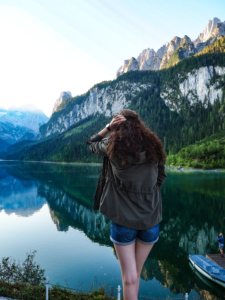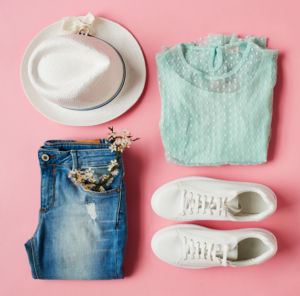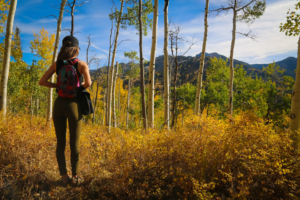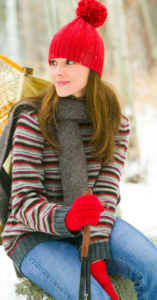
There is no poor weather for hiking, only inappropriate attires. There are some dos and don’ts that women should adhere to when choosing outfits for hiking. Yet, how you dress from head to toe determines your comfort when hiking.
Dress either for winter, spring, summer, or fall hiking is crucial. In this article, we are going to focus on exceptional hiking attires for women in all seasons. Let us delve deeper into these…
(Spring Hiking Attires for Women)

Making a spring hiking attire list makes sense in the early season of
· Fast-changing weather
· Different trail settings
Regardless of your hiking location, spring can cast windy breezes, cold air: mud, and fog.
It might not be a good day for hiking in such weather, but you can meet all these. Once you understand what you wear and carry in your backpack for spring weather, you will be ready.
Here are some attires you should wear for hiking in spring:

Long Pants
The Spring season is cold and milder. Wearing long pants for hiking keeps you warm and comfortable during chilly winds.
This doesn’t mean you have to buy the best long pants for hiking. If you are hiking under a budget, you can pull out any synthetic and non-cotton pants from your closet. For instance, your leggings, running pants, or athleisure pants can do. Whatever among these feels comfortable is ready for your hiking endeavors.

Suppose you can afford to buy new pants at the moment, get water-resistant hiking pants. That means when it drizzles while hiking, water will roll off your pants, leaving you dry and warm.
The key to decent hiking pants is choosing those that come from synthetic materials. They can either be.
· Polyester
· Nylon
· Spandex
Again, the pants must be a perfect fit to avoid pulling them up while hiking.
Shirts and Jackets
Synthetic, non-cotton, and comfortable shirts are ideal for hiking during spring.
Yet, when hiking in a cold high elevated climate, you need layers in your backpack. That is, wear a synthetic short-sleeved t-shirt.
Also, pack a lightweight synthetic and long-sleeved t-shirt. Also, ensure that you carry a warm fleece jacket.
What to carry On a Spring Hike?
Rain gear:
Rain and drizzles are common during spring. It is wise to carry a raincoat or poncho that covers you and your backpack. The rain gears keep you dry throughout your hike. When you combine rain gear and synthetic pants, they keep you warm when it’s too windy or cold.
Warm Hiking Socks:
Invest in good and warm hiking socks for your feet’ comfort. The socks also keep your feet blister-free
Hiking Boots:
Some trailing grounds are nasty and gross. They contain logs, wet rocks, and deep mud. For a good hiking experience, it is important to wear good hiking boots. Invest in trail runners with proper traction soles. Such shoes will keep you comfortable and ground.
(A Good Backpack and Cover)
Get a big backpack that is comfortable for carrying during hiking. It would be best if you carry all your items ranging from
· Drinking water
· First aid kit
· Snacks
· Extra shoes
· T-shirts
· Rain gears
Hat, Gloves, and Buffs
Another essential attire you should have for a spring hike is the neck gaiter. If you are going to hike for over three days, you can use it as a scarf, hat, or headband. The gaiter will shield you from night cold.
Hiking for several days can sometimes seem too long during spring. Besides the normal attires, there are more items that you might need, such as:
· Headlamp- To keep you in the light at night.
· Hot drink flask- for carrying hot drinks which you can sip in the cold weather.
· Plastic map case- to cover your hiking map so that it can’t get wet from raindrops.
· Dry things suck- You might have to carry some dry food in your backpack. The foods need protection from moisture, and that’s why you need to carry a dry stuff sack.
· Trekking poles- Trekking grounds during spring are muddy and slippery. Trekking poles come in handy. They help you walk to the other side.
· Carry More Food and water- When it’s cold, you eat a lot. Ensure that you pack more food for long hiking days. Water is also essential for hydration.
· Sleeping Bag- carry a sleeping bag and pad for sleeping on at night for long hikes. A small tent would also do you good since you have to sleep in it.
Once you invest in such attires and gears, spring hiking becomes easy, fun, and comfortable. Regardless of whether you are going for one to four days.
You can choose to pull out your old attires from your closet or visit a local store to buy new ones. ensure that they make your clothes of synthetic materials and waterproof.
(Summer Hiking Attires)

Summers are hot and not so good for hiking. But you can still go hiking provided you dress up well for the weather. Ensure that you.
· Wear thin socks
· Clothes that allow ventilation
· Carry light base layers
Here are some attires and things you need to carry during summer hiking.
Hiking Pants
Invest in breathable, movable, and flattering pants for hiking during summer. Try out some convertible pants that you can remove the bottom part to have longer shorts when it’s hot. Your summer hiking pants should be light and of attractive length to allow airflow.
We should make your pants and shorts for summer hiking from synthetic materials. This is because they are breathable and dry. Merino wool would also do since they boast a natural temperature regulator. They keep you cool during hot weather hikes.
Suppose you go for nylon and polyester pants. Ensure that they are polygiene and driMOTION labeled. Such technological clothes keep sweat odor away while hiking.
Breathable Shirts
Breathable long-sleeved tops are ideal for summer hiking. They protect your skin from UV light. The best of these are the UPF tops. The shirts block the sun from reaching your skin. They should also have ventilation panels that aid in air circulation to keep your skin cool.
Breathable, seamless socks
Too much heat on your feet causes blisters. When shopping for summer hiking socks, ensure that you buy merino woolen socks. If you are hiking for several days, consider seamless socks. Avoid cotton socks at all costs since they take time to dry out.
Wide-brimmed Hat and Neck Gaiter
A wide-brimmed hat protects your face and neck from the sun. You can also carry some sunscreen for your face and neck in case the UV lights hit you hard to prevent sunburns. Another attire for neck protection is the neck gaiter. Use it on your neck to prevent sunburns.
Hiking Harness Backpack
Summers need a hiking backpack that boasts the right harness. The harness allows air to flow between you and it. It also keeps you cool and comfortable throughout the hike. For a day hike, get a 29L, and for longer days, hikes 75L would be ideal.
Summer Hiking Accessories
Whether you are planning to go for a one-day hike or longer days, here are some staple have accessories
· Water bottle- For carrying at least 2L of water
· Sunscreen- For protection against UV rays.
· Sunglasses- for protection against UVC, UVA rays.
· Walking poles- For helping you walk without using too much energy
· First-aid-kit- to keep your emergency ready in case you get minor cuts and bruises.
· Electrolytes- These are for adding to your water. They keep you more energized throughout your hike.
· Emergency raincoat- For shielding yourself against summer rain.
· Sleeping-bag- if you’re planning to hike for days, ensure you carry a sleeping bag and pad to lie on during the night.
· Portable camping tent- For long days hiking, you will need a tent to stay in during the night.
· Mosquito repellent- during summer, there are very many mosquitos in bushy areas. Ensure that you carry a repellent to keep off mosquito bites.
Hiking Boots
Summer hiking boots vary according to the hiking terrain. But, ensure that you wear hiking boots that offer ankle support and are breathable.
(Hiking Outfits for Women During Fall)

Fall makes the best time for hikes. The weather is cool, windy and sometimes rainy. Dressing for fall hikes needs quick-drying and waterproof fabrics like synthetics. At all costs, you should stay away from cotton and denim.
The best attires for fall hiking should keep you warm but not hot. They should also have ample breathing space for your comfort.
Base Layers
Ensure that you invest in base layers that keep you warm and regulate your body temperature. Such layers don’t overheat or turn hypothermic when wet clothes cling to your body.
Get a thin down synthetic insulated sweater. Even a fleece jacket works well in fall hikes. On top of it, carry an extra insulated jacket. This is for emergency changes in weather if it becomes too cold, windy, or rainy.
Jacket
Suppose the weather forecast reads no rain on your hiking day. Grab a soft-shell jacket that can protect you from chilly winds. Carry it along with a waterproof layer.
Pants
Waterproof pants are the way to go during fall. You can also wear insulated thick fabric pants to shield you from wind. But they should be breathable and comfortable. Avoid jeans and cotton pants during fall hikes as they take longer to dry. If worn for long hiking days, they may cause hypothermia.
Foot Wear
During fall, you will find beautiful leaves all over the ground. , they make the ground slippery, and you can trip and fall. For better hikes, choose footwear that has rugged soles with good traction.
You can go for Salomon boots or lower shoes. Compliment your shoes with woolen socks at that.
· Provide amortization
· Prevent blisters
· Provide temperature insulation
Gloves, Hat, and Buffs
Carry one or two buffs in your backpack that you can use as a headband or scarf. Also, carry a simple beanie to protect your head from cold. Gloves are also essential for keeping your hands warm in cold weather. Get some woolen or leather waterproof gloves for rainy and cold weather.
Extra Items
Besides fall hiking attires, there are a few gears you need to carry. Regardless of whether you are hiking for a day or over three days. Fall boasts of shorter days, and 6 pm looks like 4 pm. So, get prepared for weather surprises.
Think about protecting everything in your bag, from electronics to foodstuff. Here are a few items that you should carry with you, such as:
· Headlamp– If you plan on hiking for days, ensure that you carry a headlamp. It is a great tool for longer hikes when darkness strikes. You can also use it as your camping tent during the night.
· Hot drink flask– Falls whether range from warm-cold to windy. You would like to keep your body warm throughout your hike, whether it’s a one-day or three days’ hike. The hot drinking flask comes in handy when you need to carry hot beverages. The beverages are good for sipping while trekking.
· Power Bank– You have heard of instances where people go hiking and their phones go off in the middle of nowhere. With the advancement of technology, you cannot afford not to have a power bank while hiking. Power banks save your phone from going off since they store power energy. Use it to charge your phone when it goes off.
· Camera– Falls make for beautiful sceneries. While hiking, you might come across beautiful and attractive landscapes, trees and flowers. How about taking photos for future reference? This is where a camera comes in handy.
· Trekking poles– When hiking, always carry your trekking pole. It is a great aid when walking. It helps you to trek on muddy and slippery terrains.
· Bright colored vest/hat – If you are hiking in hunting areas, consider wearing bright-colored reflectors for safety. You can dress in bright orange or green vests.
(Dressing for Winter Hiking)

When winter knocks in, change your hiking attires to something warm and comfortable. Invest in waterproof and insulated attires. You need to know the best material that will keep you from getting wet, cold, and worse off contracting hypothermia.
Besides, winter is a good season to go for hikes since most people stay indoors. Here are some outfits that you need for an enjoyable hike.
Sports bra
Get a sports bra with a mixture of Nylon, Polyester, or spandex material. Your bra gets direct attachment to your skin, and it’s the first piece that gets into contact with your sweat. Synthetic bras are breathable moisture, leaving you dry and comfortable when hiking.
Yet, it should be a perfect fit so that you can have space for breathing and swinging your arms. For instance, you can invest in underwine or ahem bras. Both keep you warm and in place.
Base Layer
On top of the bra, wear a base layer for moisture management. You can begin with a tank top. Put on the insulating top as your second layer. This lies next to your skin and controls your body temperature. It absorbs sweat from your skin, keeping you warm and dry.
Your second layer should be light to medium weight. You can consider a mixture of nylon and merino wool.
Your last layer is the out layer. We wear it after hiking up the hill or when descending. The outer layer aids in keeping the hill by trapping air in your body. That means the outer layer has to be a puffy coat made of down. It is rich in warmth.
Windproof Jacket: You can also consider putting on a windproof jacket. The jacket protects you from snow, wind, and rain.
Leggings
Your lower body is important, and keep it warm at all costs when hiking during winter. First off, invest in legging made from a mix of Nylon, Spandex, and Polyester.
They ease your movement and give you the needed comfort when hiking.Further, they have to be waterproof to keep you dry always. A good example of winter hiking leggings is activewear leggings.
They are available in various stores. Besides, because of their high demand, they have become quite affordable.
Foot Wear
Boots are essential for hiking. They should be light, waterproof, and comfortable on your feet. Moreover, they should be able to hold your ankle when hiking. To make your boots waterproof, you can spray them with water repellant and allow them to dry. Once they are ready, they hardly get wet.
Before wearing your boots, ensure that you put on woolen socks. They should be smooth, secure, and comfortable to your feet. That means that they can protect your feet from blisters and bunches. Merino woolen socks are a noble example of good winter socks.
Gaiters, Beanie, and Gloves
Get yourself some winter gaiters to keep snow away from your shoes. They are also good at keeping your calves warm during winter hikes. You can hook the gaiters under your shoes to the top and around the upper calf side. This prevents them from slipping off and keeps your shoes dry.
For beanies, ensure you carry over two when planning to go hiking for days. You can put them on when descending. The beanie regulates your body temperature by keeping you warm. It also prevents your head from losing heat to the thin air.
Gloves are a staple while hiking during winter. You should carry over two pairs of gloves. We should make them of the soft and warm inner lining and thick Polyester on the outer surface.
Sunglasses-for protecting your eyes against snow reflection. They also shield your eyes from the sun’s UV rays.
Apart from attire, ensure that you carry a thermal hot cup for sipping hot beverages. Remember that your body needs a lot of warmth during winter.
Final Thought-
Hiking is fun no matter the season we are in. Provided you have the right attire and items; you will enjoy the adventure as a family or with friends.






